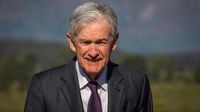In a pivotal moment for the U.S. economy, Federal Reserve Chair Jerome Powell left the door open to potential interest rate cuts during his speech at the Jackson Hole Economic Policy Symposium on August 23, 2025. This address, delivered in the scenic setting of Grand Teton National Park, Wyoming, comes amid mounting political pressure from President Donald Trump and growing concerns about the health of the labor market and inflation.
Powell’s remarks were closely watched by financial markets, policymakers, and economists, as uncertainty hangs over the direction of U.S. monetary policy. According to AFP, Powell warned, “Downside risks to employment are rising,” and described the current labor market as “a curious kind of balance that results from a marked slowing in both the supply of and demand for workers.” These comments reflect a stark shift from the robust job growth seen in recent years, and underscore the delicate balancing act the central bank faces.
The economic backdrop is complicated. Powell pointed out that economic growth has slowed significantly, dropping to an annual rate of 1.2% in the first half of 2025, down from 2.5% the previous year. As reported by The Associated Press, he noted that tariffs imposed in recent years have started to drive up consumer prices, with their effects expected to accumulate over the coming months. “The effects of tariffs on consumer prices are now clearly visible,” Powell said, while vowing, “We will not allow a one-time increase in the price level to become an ongoing inflation problem.”
Yet, the specter of inflation is not the only challenge. The Fed’s key short-term interest rate, which influences everything from mortgage rates to auto loans, stands at 4.3% as of late August. President Trump has publicly called for more aggressive action, demanding rates as low as 1%—a move that no Fed official currently supports. Trump’s criticism has been relentless, frequently labeling Powell as “Too Late” and accusing him of missing the window for decisive action. “We call him ‘Too Late’ for a reason,” Trump told reporters, according to AFP, adding that Powell should have cut rates a year ago.
This public campaign has placed Powell and the Fed in an unenviable position: how to respond to evolving economic risks without appearing to cave to political demands. Powell, who has historically resisted such pressure, emphasized in his speech that “policy isn’t on a preset course and will continue to be based on the incoming data and the balance of risks,” as Oxford Economics’ chief economist Ryan Sweet noted. The Fed, it seems, is preparing for a gradual and data-driven approach to any adjustments in monetary policy.
The stakes are high not just for the central bank, but for the broader financial system. The S&P 500 experienced three consecutive days of losses in August as political tensions around the Fed escalated, and gold prices surged by nearly 1%, signaling investor anxiety. German 30-year bond yields also reached levels not seen since 2011, reflecting the global ripple effects of perceived threats to the Fed’s independence, as highlighted by AInvest.
Much of the recent turmoil centers on the controversy involving Fed Governor Lisa Cook. Trump has threatened to fire Cook if she does not resign, following unsubstantiated allegations of mortgage fraud—a charge she has denied. “I have no intention of being bullied to step down,” Cook previously stated, according to AFP, vowing to take questions about her financial history seriously. Legal experts, as cited by AInvest, warn that removing a Fed board member without clear evidence of wrongdoing would set a dangerous precedent, given federal laws that require cause for such action. The threat alone, however, has further destabilized markets and raised questions about the central bank’s resilience.
For investors, these developments serve as a cautionary tale. The risk, as AInvest details, is that if the Fed’s independence is compromised, monetary policy could become a tool for short-term political interests rather than a stabilizing force for the economy. This could lead to inflationary spirals, currency devaluation, and higher borrowing costs—outcomes that would undermine decades of carefully built credibility. In response, financial strategists recommend hedging against currency devaluation by investing in gold, Treasury Inflation-Protected Securities (TIPS), and the Swiss franc, as well as diversifying global exposure to mitigate risks from a weakening U.S. dollar.
The Fed’s own officials are acutely aware of the challenges. Beth Hammack, president of the Federal Reserve’s Cleveland branch, underscored her commitment to the institution’s independence in a recent interview with The Associated Press. “I’m laser focused ... on ensuring that I can deliver good outcomes for the public, and I try to tune out all the other noise,” she said. Hammack remains cautious about the persistent threat of inflation, noting, “Inflation is too high and it’s been trending in the wrong direction. Right now I see us moving away from our goals on the inflation side.”
Despite the noise, Powell did not directly address the Fed’s independence in his Jackson Hole speech—a move seen by some as a deliberate signal. Adam Posen, president of the Peterson Institute for International Economics, told The Associated Press, “The not talking about independence was a way of trying as best they could to signal we’re getting on with the business. We’re still having a civilized internal discussion about the merits of the issue. And even if it pleases the president, we’re going to make the right call.”
Looking ahead, the Fed’s next policy meeting in September looms large. The CME Group’s FedWatch Tool suggests that markets are betting on an 85% chance of a rate cut at that meeting, a sentiment reinforced by Wall Street’s rally following Powell’s remarks—both the Dow and Nasdaq climbed about 2% that day. However, as Navy Federal Credit Union’s chief economist Heather Long observed, “While he is committed to ensuring that the tariff shocks are a one-time impact on inflation, he is telegraphing that the jobs situation is deteriorating quickly and that is the biggest risk now.”
Powell’s term as Fed Chair is set to end in May 2026, and this was his final Jackson Hole speech in that role. As the central bank navigates this period of heightened scrutiny and political interference, its actions will serve as a test of its institutional resilience. The outcome will not only shape the immediate trajectory of U.S. monetary policy, but could also determine the future credibility of one of the world’s most important financial institutions.





